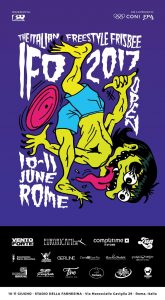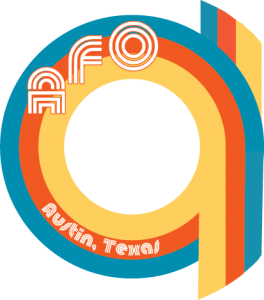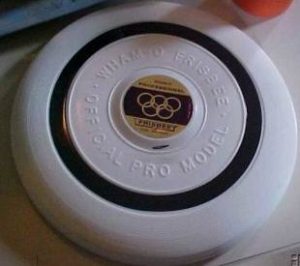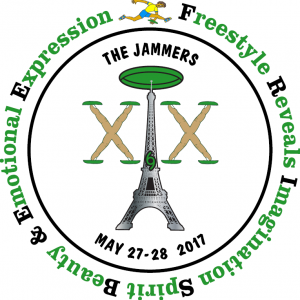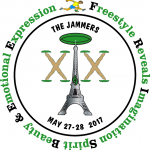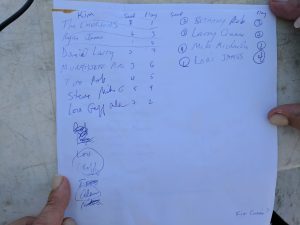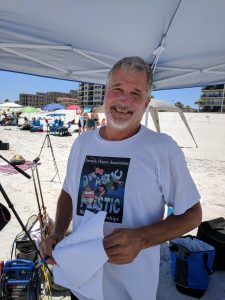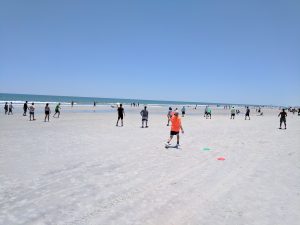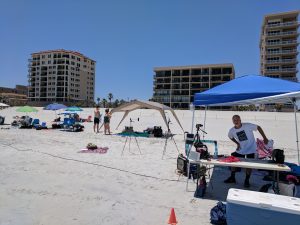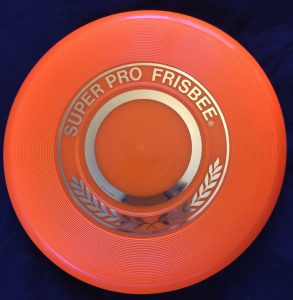 Inspired by the historical first ever Freestyle for Pairs competition that Ken Westerfield and Jim Kenner put on at the Canadian Open, Dan Roddick hosted the first annual Jersey Jam on Columbus Day weekend, October, 12th and 13th, 1974, which featured a singles format judged freestyle event. The event was held in Johnson Park, New Brunswick NJ
Inspired by the historical first ever Freestyle for Pairs competition that Ken Westerfield and Jim Kenner put on at the Canadian Open, Dan Roddick hosted the first annual Jersey Jam on Columbus Day weekend, October, 12th and 13th, 1974, which featured a singles format judged freestyle event. The event was held in Johnson Park, New Brunswick NJ
The Saturday of that weekend was devoted to disc golf, and Sunday was focused on the singles format freestyle event in which each participant was to receive a given number of throws from a designated thrower. The judging system was the same sort of basic ranking scale that was introduced and used for the Canadian Open Freestyle event that previous August. The Super Pro Frisbee disc had made its debut by then, and was used by the majority of the competitors.
Included in the field were John Kirkland from Boston, and Victor Malafronte from the Berkeley BFG. From Chicago came John Connelly, Tom Cleworth and Jose Montalvo. John Sappington and Scott Dickson came from Ann Arbor Michigan. Kerry Kollmar and Mark Danna swooped in from New York City. Peter Bloeme, making his Frisbee competition debut, came along with Mark and Kerry. Irv Kalb, Jimmy Scala, Stork, Bob “Flash” Kingsley, Gary Seubert, and Dave “Buddha” Meyers comprised the local New Jersey contingent. Jim Palmeri and Doug Corea drove down from Rochester, NY.
As Jim Palmeri recalls, the participants of the Jam woke up that Sunday morning to the most perfect October weather you could imagine; blue sky, 70 degrees, and just a whisper of a steady breeze. The fall leaves were turning color and gently wafting down around us from the trees of Johnson Park. If only there was a video of the setting to show everyone how ideal the conditions were. They were truly perfect for the memorable event that unfolded that day.
The refinements in multiple tipping control and smoothness of catch and re-throw that developed since the epic jamming that took place at the American Flying Disc Open two months earlier were phenomenal. As each of the competitors took their turn, it seemed that the crowd had to be thinking “Wow, how can anyone top this!” Some of the competitors did indeed come up with something extra. When John Kirkland got up there and displayed his stuff with all the bravado he is noted for, it seemed that it was all over as far as who the winner was going to be. But then Scott Dickson followed with a drop-less routine as clean as you could be for the times. He peaked with a beautifully executed finger-tip that sent the disc over his head and straight down behind him, then flicked his foot backwards just at the right moment and popped the disc straight back up with his heel, executed a leaping half turn into the air and caught the disc between his legs. From the throw to final catch the disc did not wobble a millimeter. From today’s standards that may not sound like much. But on October 13th, 1974, especially when his Frisbee of preference was the smaller, faster “Pro Model” guts disc, it was absolutely phenomenal. It seemed unlikely that anyone would top Scott’s routine.
But then Stork took the field, his designated thrower was Irv Kalb, perhaps the best thrower on the planet at that time, delivering Stork exactly what he needed for a very well planned out and choreographed set of throws. His first couple of throws went as expected. They consisted of a tip or two of control, closed by a basic behind the head or behind the back catch. Well executed and very clean, but no Scott Dickson beaters. Dan then gave Irv a signal, and Irv delivered a mighty air bounce with as much spin as humanly possible. Stork reached up with a thimble-covered finger, made contact with the spinning disc on the underside of its rim, changed its attitude upward a bit, and then flicked it away from him into the wind. He chased after it, striking the disc on the rim with his hand when he got to it, causing the disc to glide away from him. Stork sprinted after the disc, and again propelled the disc away. He repeated this sequence of rim strikes a couple more times, and then after the final whack, he did a high graceful hurdler style leap, catching the disc between his legs at peak height. No one had ever seen such a sequence of moves! He had kept it a secret because he wanted to showcase it at the Jersey Jam for effect, and boy did it have effect! Everyone was just blown away! Stork continued his routine by treating us to a couple more sets of the rim striking sequence before closing with an introduction to the constorktion type of catches for which he was to become known for during the early freestyle era. The competitors make the judgment that Stork’s routine was the best, and declared him the winner of the first-ever freestyle event to be held in the USA.
In historical perspective, Stork was the first person to ever use a thimble on his finger during a routine, using it effectively to set the disc up for his particular moves. However, he got the idea from observing Jose Montalvo at the ’74 Canadian open using a “Molina stick” to set up an incoming disc for just the right attitude to do neat behind the back and between the legs catches. Dan figured that he would take it a step further and incorporate a new move that he had seen Kerry Kollmar do earlier in the year at Rochester. The use of the thimble was key because at that time no one could consistently get the disc positioned for propelling it forward with repeated strikes to its outer rim as Dan demonstrated in his Jersey Jam routine. Kerry, who initially had invented the move, had called it “side tapping,” but Stork was unaware of that name when he first learned the move from Kerry, and had dubbed it “air brushing” when describing Kerry’s invention in subsequent discussions about freestyle. The term “Air Brushing” was first seen in print in a Flying Disc World newsletter article, and that name stuck ever after.
The impact that the Jersey Jam competition had on the players was a significant catalyst to the already rapidly growing interest in freestyle competition, and set the stage for what was to come.
During this fall 1974 period of time, John Kirkland and Victor Malafronte getting hired to do the pregame entertainment program for the 1974-1975 Harlem Globetrotter nationwide basketball game exhibition series further set the stage for the development of freestyle. Ed Headrick invited the core group of competitors at the Jersey Jam to a reception for John and Victor at Radio City Music Hall in New York City that Saturday evening of the Jersey Jam weekend to announce the big news about the guys getting hired for the gig. Throughout the entire 1974-1975 basketball season, thousands of people from coast to coast were exposed to an exciting freestyle exhibition for the very first time, and who knows how many of the spectators went home and tried fancy Frisbee throwing for themselves after seeing John and Victor do their magnificent exhibition.
Last Article | Next Article
Thanks to the Freestyle Players Association (FPA) for sharing this information with FrisbeeGuru.com.
The entire document is stored on FreestyleDisc.org, as is the FPA’s Hall of Fame.



